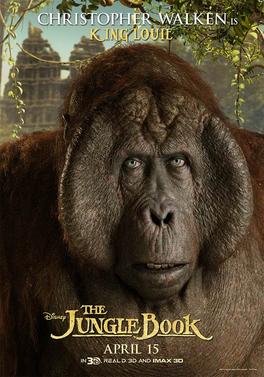King Louie
King Louie is a fictional character introduced in Walt Disney's 1967 animated film, The Jungle Book. He is an orangutan who leads a group of monkeys and is known for his desire to become more human by learning the secret of "man's red flower" (fire).
Character Overview[edit | edit source]
King Louie is depicted as a fun-loving, jazz-singing orangutan who rules over the other monkeys in the jungle. He is characterized by his ambition to obtain the secret of fire from the film's protagonist, Mowgli, a human boy raised by wolves. King Louie believes that by mastering fire, he can become more like humans and gain greater power and influence in the jungle.
Role in The Jungle Book[edit | edit source]
In The Jungle Book, King Louie captures Mowgli and tries to persuade him to reveal the secret of fire. He sings the song "I Wan'na Be Like You" to express his desire to be more human. However, Mowgli does not know how to make fire, and the encounter ultimately leads to a chaotic chase scene where King Louie's palace is destroyed.
Voice Actors[edit | edit source]
In the original 1967 film, King Louie was voiced by Louis Prima, a well-known jazz musician. In the 2016 live-action/CGI adaptation of The Jungle Book, the character was voiced by Christopher Walken. This version of King Louie is depicted as a Gigantopithecus, an extinct genus of ape, rather than an orangutan.
Cultural Impact[edit | edit source]
King Louie has become one of the most memorable characters from The Jungle Book and has appeared in various other media, including television series, video games, and theme park attractions. His song "I Wan'na Be Like You" remains one of the most popular and recognizable songs from the film.
Controversy[edit | edit source]
The character of King Louie has been the subject of some controversy. Critics have argued that the character perpetuates racial stereotypes, particularly in the context of the original film's release during the Civil Rights Movement in the United States. The depiction of King Louie as a jazz-loving, power-hungry character has been interpreted by some as a caricature of African American culture.
Appearances in Other Media[edit | edit source]
King Louie has appeared in various other Disney media, including:
- TaleSpin - An animated television series where King Louie runs a nightclub.
- House of Mouse - A television series where he makes occasional appearances.
- Kingdom Hearts - A video game series where he appears as a character in the Jungle Book world.
See Also[edit | edit source]
- The Jungle Book (1967 film)
- The Jungle Book (2016 film)
- Mowgli (Disney character)
- Baloo
- Shere Khan (Disney character)
References[edit | edit source]
External Links[edit | edit source]
Search WikiMD
Ad.Tired of being Overweight? Try W8MD's physician weight loss program.
Semaglutide (Ozempic / Wegovy and Tirzepatide (Mounjaro / Zepbound) available.
Advertise on WikiMD
|
WikiMD's Wellness Encyclopedia |
| Let Food Be Thy Medicine Medicine Thy Food - Hippocrates |
Translate this page: - East Asian
中文,
日本,
한국어,
South Asian
हिन्दी,
தமிழ்,
తెలుగు,
Urdu,
ಕನ್ನಡ,
Southeast Asian
Indonesian,
Vietnamese,
Thai,
မြန်မာဘာသာ,
বাংলা
European
español,
Deutsch,
français,
Greek,
português do Brasil,
polski,
română,
русский,
Nederlands,
norsk,
svenska,
suomi,
Italian
Middle Eastern & African
عربى,
Turkish,
Persian,
Hebrew,
Afrikaans,
isiZulu,
Kiswahili,
Other
Bulgarian,
Hungarian,
Czech,
Swedish,
മലയാളം,
मराठी,
ਪੰਜਾਬੀ,
ગુજરાતી,
Portuguese,
Ukrainian
Medical Disclaimer: WikiMD is not a substitute for professional medical advice. The information on WikiMD is provided as an information resource only, may be incorrect, outdated or misleading, and is not to be used or relied on for any diagnostic or treatment purposes. Please consult your health care provider before making any healthcare decisions or for guidance about a specific medical condition. WikiMD expressly disclaims responsibility, and shall have no liability, for any damages, loss, injury, or liability whatsoever suffered as a result of your reliance on the information contained in this site. By visiting this site you agree to the foregoing terms and conditions, which may from time to time be changed or supplemented by WikiMD. If you do not agree to the foregoing terms and conditions, you should not enter or use this site. See full disclaimer.
Credits:Most images are courtesy of Wikimedia commons, and templates Wikipedia, licensed under CC BY SA or similar.
Contributors: Prab R. Tumpati, MD

